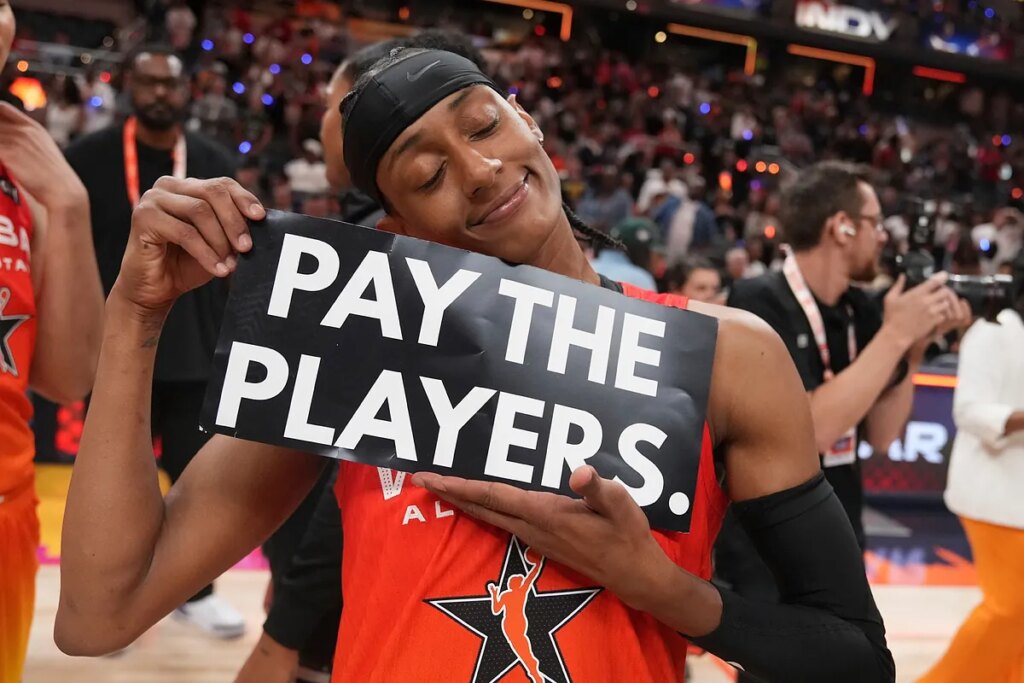WNBA revenues are increasing thanks to the arrival of players like Caitlin Clark, who have brought significant fandom and engagement. A new $2.2 billion media rights deal will kick in in 2026. Franchise valuations are on the rise, and the league is currently in the final year of a collective bargaining agreement (CBA) that actually allows players to receive only 9.3% of league revenue. The Players Association is led by Nneka Ogwumike.
With the new rights deal, revenue and commercial experts suggest that player compensation should increase by 10% to 15%, resulting in their total share of the league’s revenue reaching between 20% and 25%.
Sparks’ Kelsey Plum, Liberty’s Breanna Stewart, Storm’s Alysha Clark, and Lynx’s Napheesa Collier serve as Vice Presidents of the Association. There are theories suggesting that their involvement in the WNBA may benefit their company, Unrivaled.
I find this theory to be quite silly, much like the shirt protests. It’s hard to believe that some people doubt players’ interest in securing better pay after they have been pivotal to the WNBA’s growth in recent years. This interest spans not only the next generation of players, like Caitlin Clark, Angel Reese, and Paige Bueckers, but also those who have historically fought for women’s sports.
Moreover, the owners of Unrivaled and the league’s growth are directly tied to the WNBA’s overall success. Rather than being competitors, they serve as complementary tools. Unrivaled has created more opportunities and raised the bar for resources and pay for many players. It’s unreal why Napheesa and Stewie are sometimes viewed as having interests that may not align with player benefits or league growth.
Investments in the WNBA are surging like never before, with franchise values increasing an average of 180% over the last 12 months. Players are now fighting for a larger share of the revenue as their CBA expires this year.
Currently, WNBA players receive just 9.3% of league revenue (which includes ticket sales, merchandise, and TV deals). For reference, their male counterparts in the NBA receive 50%. This has resulted in a salary cap of just $1.507 million for this year. If players were to receive even 40% of the league’s revenue, the salary cap could rise to $6.481 million. Such an increase could allow for roster expansion, theoretically enabling players to earn three times their current salaries while owners would still retain 60% of the revenue.
While the WNBA lost $40 million in 2024, this was largely due to the existing TV deal. Starting in 2026, the TV deal will increase from around $45 million annually to approximately $200 million annually. This change could result in the league turning a profit almost overnight-transitioning from a loss of $40 million to a net gain of $115 million based solely on the TV deal. Even if game attendance, ticket sales, and merchandise sales remained stagnant, the league would still maintain positive revenue.
With the current CBA, player salaries could increase from a cap of $1.507 million to $4 million-a significant raise for players, costing the league only $2.5 million from the projected $115 million in television deal profits. If players received 40% of revenues, that would mean a salary cap of $17.204 million-an 11-fold increase over current salaries.
The league is built on its players, whether they are fans of Caitlin Clark, Aja Wilson, or Napheesa Collier. They deserve a larger share of the revenue for the hard work they have put in, and as revenues grow, so should their compensation.
Read the full article here

